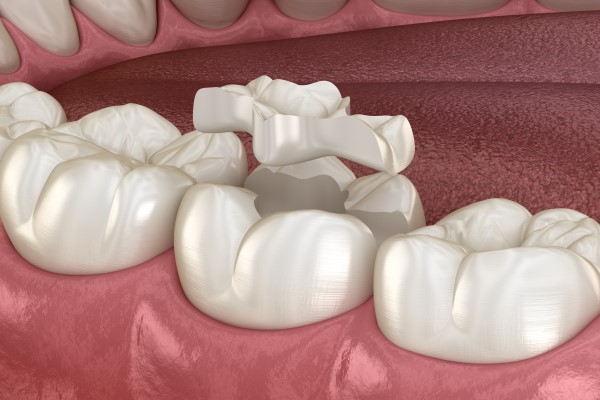How Soon Can I Eat After Getting a Dental Inlay?

A dental inlay involves a minimally invasive placement process, and most patients are able to recover fully within a few days after placement. However, it can help to avoid certain foods and drinks for a while after an inlay placement. Patients may find it challenging to eat for several hours as they adjust to the dental inlay.
Eating after a dental inlay: Here is what you need to know
There are not always specific instructions provided on how long to wait to eat after receiving a dental inlay. However, there are suggestions that dentists often provide to help ensure that there are no complications with the dental inlay and to help the patient avoid any increased irritation.
When can I eat after getting a dental inlay?
Some patients report being able to eat within an hour after receiving a dental inlay. However, some dentists recommend waiting a few hours to get used to the feel of the dental inlay and to reduce the risk of any sensitivity. There are also certain foods and drinks that should not be consumed for the first 24 hours after receiving a dental inlay.
What foods are good to eat after getting a dental inlay?
It is best to stick to foods that are soft and easy to chew for the first 24 hours and to avoid foods that are hot or cold. It is also encouraged to only drink water for the first 24 hours because dark beverages (coffee, tea, and soft drinks) may cause irritation to the gums and tooth that received the inlay.
Are there foods and drinks to avoid?
Foods that are sticky, chewy, or tough could pull on the dental inlay before the cement has the opportunity to properly bond. If there is any gum or tooth irritation, foods and drinks that are high in sugar should be avoided because it could increase the risk of an oral infection while the mouth is healing after the placement of the dental inlay. Hot and cold foods may also cause irritation and sensitivity within the first 24 hours.
How can I take care of my dental inlay for the long term?
The long-term and short-term focus after dental inlay placement should be on having good oral hygiene (brushing, flossing, and using mouthwash consistently each day). Regular dental visits also provide opportunities for the dentist to check on the condition of the dental inlay. They can do a dental cleaning to keep the gums, teeth, and restoration(s) clean to avoid oral health concerns.
Schedule a visit to find out if a dental inlay is right for you
If you have a damaged tooth, a dental inlay may be a way for you to restore the health, appearance, and function of your damaged tooth. If you would like to schedule a visit for our team to assess the severity of the damage and provide a treatment recommendation, call our team today. We are more than happy to answer your additional questions about dental inlays.
Are you considering a dental inlay in the New York area? Get more information at https://www.newyorkdentaloffice.com.
Check out what others are saying about our dental services on Yelp: Dental Inlay in New York, NY.
Recent Posts
While some might believe visiting the dentist is only necessary for emergencies, routine dental care can be vital for oral health and overall wellness. There are a variety of benefits to seeing a dentist two or three times a year, no matter a patient’s stage of life. While regular brushing and flossing can help keep…
Good self-care habits ought to include time for routine dental care. From spending a few minutes each day on oral hygiene to visiting a general dentist throughout the year, taking care of the teeth and gums is an important part of personal health. Rather than leaving oral health to chance, implementing preventative dental care practices…
Routine dental care is vital for anyone striving to achieve optimum health. Dentists recommend two preventative dental visits per year, but much can happen between visits; therefore, it is crucial to get the most out of each appointment.Professional cleanings are an essential component of routine dental care and can remove plaque and tartar below the…
A chipped tooth can affect your smile's appearance and oral health, leading to discomfort, sensitivity, and self-esteem issues. Fortunately, there are several effective options to restore a tooth's natural look and strength. A variety of treatments are available, depending on the severity of the chip, its location, and your treatment goals.A chipped tooth can result…



